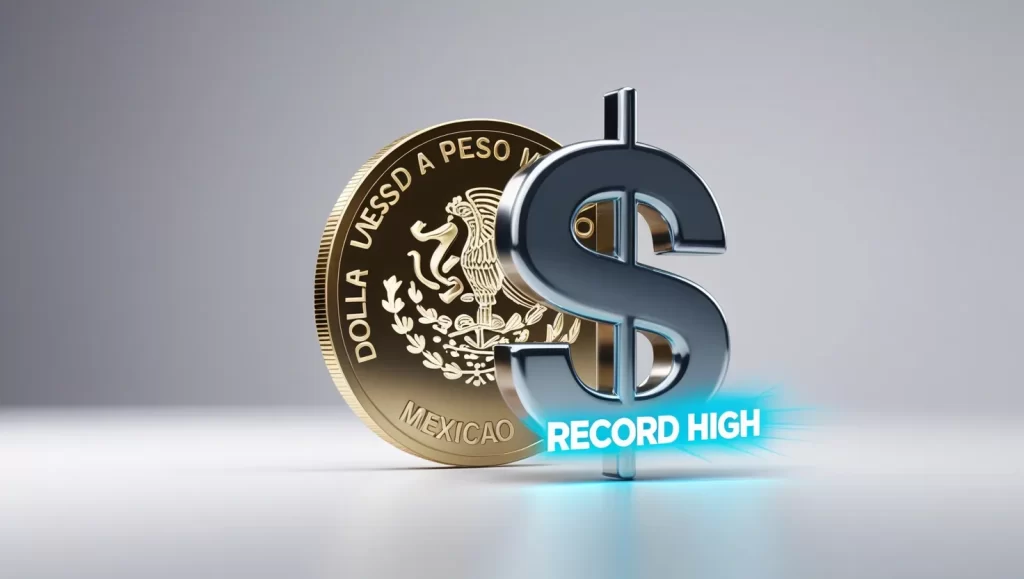Dollar USD a Peso Mexicano Hits Record High in Latest Market Trends

Dollar USD a Peso Mexicano Hits Record High in Latest Market Trends-The dollar USD a peso mexicano exchange rate has recently experienced dramatic shifts, reaching record highs in the latest market trends. This movement has caught the attention of both investors and businesses as it indicates significant changes in the economic relationship between the United States and Mexico. Understanding the factors behind this surge in the dollar USD a peso mexicano is crucial for anyone involved in currency trading, cross-border commerce, or economic analysis. In this article, we’ll explore the key drivers behind this rise, the broader economic implications, and what could lie ahead for this important currency pair.
The Surge in the Dollar USD a Peso Mexicano Exchange Rate
The dollar USD a peso mexicano exchange rate hitting record highs is an indication of a number of complex economic forces at play. While a stronger U.S. Dollar can be a sign of a robust U.S. economy, it can also indicate underlying issues that are influencing currency markets worldwide. In the case of the dollar USD a peso mexicano, the movement toward record highs has been driven by multiple factors, including domestic economic policies, global geopolitical developments, and changes in investor sentiment.
What’s Behind the Stronger Dollar?
A number of factors have contributed to the strengthening of the dollar USD a peso mexicano exchange rate. The most notable is the U.S. Federal Reserve’s interest rate policy. As the U.S. central bank has raised rates to combat inflation, the value of the Dollar has increased due to higher returns on U.S. assets, making the Dollar more attractive to investors. The higher the interest rates, the greater the incentive for international investors to park their money in U.S. assets, driving up demand for the Dollar.
Additionally, the U.S. economy’s resilience, despite global challenges, has added to investor confidence in the dollar USD a peso mexicano. This confidence has propelled the Dollar to stronger positions not only against the Mexican Peso but also against other major currencies like the Euro and the Japanese Yen.
Economic Policies Impacting the Dollar USD a Peso Mexicano

In addition to the Federal Reserve’s policies, the U.S. government’s economic approach and fiscal policies also play a significant role in shaping the dollar USD a peso mexicano exchange rate. Over the past several years, the U.S. has experienced substantial fiscal spending, which has fueled the economy but also contributed to inflationary pressures. Despite inflation concerns, the stronger dollar has been a byproduct of these policies, as investors flock to the U.S. for its perceived economic strength.
The dollar USD a peso mexicano also reflects the shifting dynamics in trade relations. The U.S.-Mexico trade relationship is vital to both economies, and changes in trade policies, tariffs, and agreements can all contribute to fluctuations in this currency pair. Recent global trade disruptions have further emphasized the dependence of Mexico’s economy on the U.S. market, contributing to the Peso’s vulnerability relative to the Dollar.
U.S. Trade Deficit and Its Effects
Another factor contributing to the strength of the dollar USD a peso mexicano is the U.S. trade deficit. While a trade deficit often signals an imbalance in a nation’s imports and exports, it can simultaneously lead to an appreciation of the U.S. Dollar. As the U.S. imports more goods and services than it exports, foreign investors continue to exchange foreign currencies for Dollars, which can push the dollar USD a peso mexicano higher. Despite the challenges posed by the trade imbalance, the dollar USD a peso mexicano exchange rate has benefitted from the ongoing demand for the Dollar. (Read More: Dollar US to Rupee Fluctuations: Impact on Indian Economy)
Mexico’s Economic Performance and the Dollar USD a Peso Mexicano
.jpg?width=1200&height=628&disable=upscale&fit=bounds)
While the strength of the U.S. Dollar plays a key role in the dollar USD a peso mexicano exchange rate, the performance of the Mexican economy is equally important. As the Mexican economy is closely linked to the U.S., it can be significantly impacted by changes in U.S. monetary policy, inflation, and interest rates. In recent years, the Mexican Peso has struggled against the Dollar, reflecting both global and domestic factors that have weighed on the Peso.
Inflation and Economic Challenges in Mexico
Mexico’s economy has been facing inflationary pressures, though not as severe as in the U.S. Nevertheless, rising inflation and concerns about the global economic slowdown have contributed to a weaker Peso relative to the Dollar. As the dollar USD a peso mexicano hits record highs, the increased cost of imports in Mexico is putting additional strain on consumers, further amplifying inflationary concerns.
Moreover, Mexico’s dependency on U.S. trade and investment has made the country vulnerable to changes in the value of the Dollar. As the dollar USD a peso mexicano strengthens, Mexican exporters find it harder to remain competitive in international markets due to the higher costs of their goods and services when priced in foreign currencies.
The Role of the USMCA in Mexico’s Economic Outlook
The United States-Mexico-Canada Agreement (USMCA) has played a critical role in shaping Mexico’s economic future, especially in the context of its trade relationship with the U.S. The agreement, which replaced NAFTA, provides more stable trade conditions and offers some protection for Mexican industries. However, the ongoing economic pressures—coupled with the rise of the dollar USD a peso mexicano—show that Mexico’s economy remains susceptible to fluctuations in the global market. (Read More: Will the US Dollar Maintain Its Dominance in the Global Financial System in 2024?)
Global Events and Their Influence on the Dollar USD a Peso Mexicano
In addition to domestic economic factors, global events also heavily influence the dollar USD a peso mexicano exchange rate. Geopolitical tensions, supply chain disruptions, and global health crises like the COVID-19 pandemic have all contributed to increased market uncertainty. In times of global uncertainty, the U.S. Dollar tends to strengthen as investors flock to safer assets, further driving up the dollar USD a peso mexicano.
Global Commodity Prices and the Peso
One significant global factor affecting the dollar USD a peso mexicano is the price of commodities like oil, which is a major export for Mexico. As oil prices fluctuate, the Mexican Peso can be affected, particularly if the Dollar strengthens, making Mexican exports more expensive on the international market. When oil prices are high, Mexico’s economy benefits, and the Peso tends to appreciate against the Dollar. However, when oil prices fall or global demand decreases, the Peso weakens, which can further push the dollar USD a peso mexicano to new highs.
Investor Sentiment and Currency Speculation
Investor sentiment has been a crucial driver of the recent surge in the dollar USD a peso mexicano exchange rate. Currency markets are often swayed by speculation, and as investor confidence in the U.S. economy grows, demand for the Dollar increases. Speculative activity can amplify movements in the dollar USD a peso mexicano, and with heightened uncertainty in global markets, investors have shown a preference for holding U.S. Dollar assets, further driving up the exchange rate. (Read More: Dollar US to Rupee Today: Key Factors Influencing the Rate)
Implications for Businesses and Consumers

The record highs of the dollar USD a peso mexicano exchange rate have important consequences for both businesses and consumers in Mexico and the United States. For U.S. consumers, a stronger Dollar means more purchasing power when traveling abroad or buying imported goods. However, for Mexican consumers, the strength of the Dollar means that everyday goods and services are becoming more expensive as import costs rise.
Effects on U.S. Exporters and Mexican Importers
For U.S. exporters, a stronger Dollar can make their products less competitive abroad. The dollar USD a peso mexicano at record highs means that Mexican consumers face higher costs for U.S. goods. This could reduce demand for U.S. exports in Mexico, ultimately affecting American businesses that rely on trade with their southern neighbor.
On the flip side, Mexican importers face higher costs for U.S. products due to the stronger Dollar. This increases the price of goods in Mexico, affecting everything from food to electronics. For industries reliant on U.S. imports, this currency shift adds a layer of complexity and cost.
The Future of the Dollar USD a Peso Mexicano
As the dollar USD a peso mexicano continues to hit record highs, many analysts are closely monitoring the factors that will shape its future. While the U.S. Dollar’s strength has been driven by robust economic policies and investor sentiment, the ongoing economic pressures in both the U.S. and Mexico suggest that volatility will remain a key feature of this currency pair.
The trajectory of the dollar USD a peso mexicano will depend on how the U.S. Federal Reserve manages interest rates, how Mexico navigates its inflationary pressures, and how global events impact market sentiment. As both economies evolve, the dollar USD a peso mexicano will continue to be an important indicator of global financial health.





